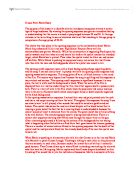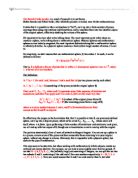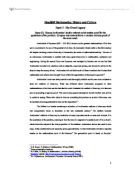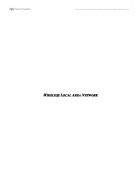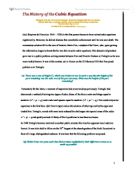The topic we have chosen to investigate for our maths assignment is 'sequences'. In order to do this we will firstly show a diagram of matchstick shapes increasing in size.
Introduction The topic we have chosen to investigate for our maths assignment is 'sequences'. In order to do this we will firstly show a diagram of matchstick shapes increasing in size. Our first chosen stage is a triangle, in the second stage we will draw a table of results, the top line representing the orders of terms and the bottom line will represent the number of matchsticks used to make the sequence. From this table we will be able to see the 'number increase' in each step of the sequence. With this information we hope to find the formula for the 'nth term'. The 'nth term' is merely a representation of the order of sequence; therefore it can be substituted for any value in sequence. By using the formula we should be able to predict any number of the sequence. In order to find our formula we must have a consistent increase in our number of matchsticks. Since we have this we can look at number 4 in the order of sequence and compare it with the corresponding number of matchsticks. We see that the number of matchsticks is twice the size of number 4 plus 1. This is written as 2n+1 Where n represents the order of sequence. The formula 2n allows us to work out any number in the sequence. Working out the difference in the number of matchsticks derives this formula (in this case the result is 2) we then multiply this difference by the order of sequence (this gives us
Point Blank - The purpose of this essay is to identify why the introductory sequence attracts a certain type of target audience.
Grosse Point Blank Essay The purpose of this essay is to identify why the introductory sequence attracts a certain type of target audience. By viewing the opening sequence you gain an immediate feeling or understanding that the movie is aimed at people aged between 20 and 30. At this age violence is the norm thing to see on television and is not that shocking to the age group in comparison of an age group of 50-60. The events that take place in the opening sequence are the conversation about Martin Blank the professional killer's ten year High School Reunion Party with his secretary/business partner Marcella. Whilst the conversation is happening Blank spots the cyclist assassin and then takes aim and shoots him before the cyclist reaches his intended target, which Blank has to protect. Then when the cyclist is shot he hits a car and comes off his bike. Whilst Blank is packing his equipment away, out comes his rival Grosse who then kills the man and his bodyguards which the cyclist was meant to kill. The opening credit sequence opens with a black background perhaps signalling death, and the song 'I can see clearly now' is played over both the opening credit sequence and opening assassination sequence. This song gives off an air of black humour in the mood of the film. This seems very hypocritical because the song is uplifting and the sequence is very violent and serious.
Analyzing First Order Kinetics - cis-trans isomerization of mercury dithizonate
The Hong Kong Polytechnic University Bsc(Hons) in Chemical Technology Chemistry Laboratory III Laboratory Report Inorganic Chemistry Experiment 6 Title: Analyzing First Order Kinetics - cis-trans isomerization of mercury dithizonate Name: KO KA LEE Student ID: 02183698D Class: 12047-2 Aim: The purpose of this experiment is to analyze first-order kinetics and rate constant by using four general methods: . Half-time method 2. Semi-log method 3. Guggenhein's method 4. R/R? method (ratios of rates). Results and Data Treatment: Half-time Method From the data obtained (Appendix 1), a graph of absorbance Y(t) against time is plotted. Graph 1 For 1st order kinetics, t = t1/2 y t1/2 = (y0 + y? ) / 2 From the data, y0 = 0.2969208 y? = 0 y t1/2 = (0.2969208 + 0) / 2 = 0.1484604 From Graph 1, At absorbance 0.1484604, t1/2 = 21.5s By kobs = ln2 / t1/2 , kobs = ln2/ 21.5 = 0.0322 s-1 Semi-log Method A graph of Z(t) = ln[yt-y?] against time is plotted. (The value of ln[yt-y?] refer to Appendix 3) Graph 2 From the equation, y= -0.0249x - 1.5439 Slope of graph = -kobs = -0.0249 ? kobs = 0.0249 s-1 Guggenhein's Method Take ?t = 1 A graph of Z(t) = ln[y(t+?t)-yt] against time is plotted. (The value of ln[y(t+?t)-yt] refer to Appendix 3) Graph 3 From the equation, y= -0.0276x - 4.9105 Slope of graph = -kobs = -0.0276 ? kobs = 0.0276 s-1 R/R?
How many squares are there on a chessboard?
How many squares are there on a chessboard? The aim of this investigation is to find out how many squares and rectangles of specific sizes can be found on a chessboard, and too see if there is a common sequence and algebraic formulae for each example. I have started with the simplest example that is to count the different combinations of squares on a range of boards from 2x2 board up to an 8x8 board. Results from the count 2x2 board x1=4 2x2=1 3x3 board x1=9 2x2=4 3x3=1 4x4 board x1=16 2x2=9 3x3=4 4x4=1 5x5 board x1=25 2x2=16 3x3=9 4x4=4 5x5=1 6x6 board x1=36 2x2=25 3x3=16 4x4=9 5x5=4 6x6=1 7x7 board x1=49 2x2=36 3x3=25 4x4=16 5x5=9 6x6=4 7x7=1 8x8 board x1=64 2x2=49 3x3=36 4x4=25 5x5=16 6x6=9 7x7=4 8x8=1 When the 8x8 boards results are analyzed a quadratic sequence can be identified i.e the second difference is a constant. term No of squares st diff 2nd diff 64 2 49 5 3 36 3 2 4 25 1 2 5 6 9 2 6 9 7 2 7 4 5 2 8 3 2 Using the general term for a quadratic sequence where A= 1/2 the constant 2nd difference, which is 2x 1/2 = 1 Yn=An + Bn + C So y1 = 1x1 + B x 1 + C = 64 So B + C = 64 - 1 B + C = 63 Y2 = 1x2 + B x 2 + C = 49 4 + 2B + C = 49 so 2B + C = 45 we now solve the simultaneous equation B + C = 63 2 B + C = 45 ?- B = 18 OR B = - 18 if B = - 18 then C = 63 - (-18)=81 so the
Case Analysis: Forecasting Food and Beverage Sales
CASE ANALYSIS: FORECASTING FOOD AND BEVERAGE SALES Suzanne Michelle Gager QNT 531: Advanced Problems in Statistics and Research Methods Terrance C. Feravich March 20, 2006 Case Analysis: Forecasting Food and Beverage Sales Problem Definition The Vintage Restaurant is on Captiva Island, a resort community near Fort Myers, Florida. The restaurant, which is owned and operated by Karen Payne, has just completed its third year of operation. During that time, Karen has sought to establish a reputation for the restaurant as a high-quality dining establishment that specializes in fresh seafood. The efforts of Karen and her staff have proven successful, and her restaurant has become one of the best and fastest-growing restaurants on the island. Karen has concluded that to plan for the growth of the restaurant in the future, she needs to develop a system that will enable her to forecast food and beverage sales by month for up to one year in advance. Karen has the following data ($1000s) on total food and beverage sales for the three years of operation. Lost Beverage and Food Sales Case Vintage Restaurant Sales MONTH First Year Second Year Third Year January 242 263 282 February 235 238 255 March 232 247 265 April 78 93 205 May 84 93 210 June 40 49 60 July 45 57 66 August 52 61 74 September 10 22 26 October 30 30 48 November 52
Banach-Tarski Paradox Talk
The Banach-Tarski paradox is a result of research in to set theory. Stefan Banach and Alfred Tarski, after which the paradox is named, were Polish mathematicians. It states that it is possible to take a solid sphere (a "ball"), cut it up into a finite number of pieces, rearrange them using only rotations and translations, and re-assemble them into two identical copies of the original sphere, effectively doubling the volume of the sphere. It's important to be clear what we're talking about. The most important point is that when we mention a sphere, we're talking about a mathematical sphere. Physical spheres and mathematical spheres are not entirely congruent, the most important distinction being that a mathematical sphere is infinitely divisible. As a physical sphere contains a finite (albeit large) number of atoms, it is not so. For simplicity, we shall assume that our mathematical sphere, S, has radius 1. As such, it can be defined as follows: S = {(x,y,z) | x2+y2+z2 ? 1 } That is, S is defined as the set of points that lie within a 3-dimensional spherical area in R3, where R is the set of all real numbers. The Definition: Ai n Aj = Ø for each i and j between 1 and n such that i=j (no two pieces overlap each other) A1 ? A2 ? ... ? An = S (assembling all the pieces yields the original sphere S) There exist T1, T2, ... Tn, where each Ti represents some finite
Greek Maths
Mas3039 Mathematics: History and Culture Topic 2: The Greek Legacy Essay (2): Discuss Archimedes' double reductio ad absurdum proof for the quadrature of the parabola. Compare and contrast this to a modern calculus proof of the same result. Archimedes of Syracuse (287 - 212 BC) is known as the greatest mathematician of his time and is considered to be one of the greatest of all time. He dominated Greek maths in the third century BC despite not being a native of the city of Alexandria, the centre of mathematical activity.1 The son of an astronomer, Archimedes is credited with many great discoveries in mathematics, mechanics and engineering. During the second Punic war Syracuse was besieged by Romans and we are told that Archimedes invented war machines such as catapults, ropes and pulleys, and devices to set fire to the ships to keep the enemy at bay.1 Archimedes did not think much of these inventions but it meant that mathematics and science were brought "more within the appreciation of the people in general".2 Archimedes' work was both productive and thoroughly detailed and he was never reluctant to share his methods of discovery. What was different about Archimedes compared to other mathematicians of his time was the fact that his work illustrated his method of discovery of a theorem prior to presenting a rigorous proof. This was to stop people claiming his work to be
Lesson Plan for Physical Education Year GroupKS1 AreaSports hall/gym with apparatus ThemeTravelling in different directions
Lesson Plan for Physical Education Year Group KS1 Area Sports hall/gym with apparatus Theme Travelling in different directions Learning Objectives They should improve on their knowledge of travelling in different directions and successfully put these different ways together in a sequence on both the floor and the apparatus. N.C Reference/ELGs PE KS1 1a, 1b, 2a, 2b, 3a, 3b, 5, 8a, 8b, 8c, 8d. Resources Apparatus including 5 planks, 6 mats, 4 trestle tables and 2 benches. Vocabulary Travel, sequence, link, combine, direction, sideways, backwards, forwards. Activities In the warm up ask the children to move using only their feet. Ask them to come up with different ways that they could do this. For example running, walking, skipping, hopping etc. Then ask them to move using both their hands and their feet - see how many different ways they can come up with. Encourage them to keep moving, move into space and to change direction. (8 minutes) Ask the children to come up with three or four ways of travelling using a combination of hands and feet remembering to think about direction. Using mats they should practice these three or four travelling movements. They should also think of a starting and finishing position. (15 minutes) Supervise the children putting out their designated apparatus. In groups of 6 ask the children to practice their sequence on the particular
Wireless Local Area Network
WIRELESS LOCAL AREA NETWORK WIRELESS LOCAL AREA NETWORK Table of Contents . INTRODUCTION - Context of the Problem - Statement of the Problem - Research Questions - Significance of the study - Objective of the Study - Research Methodology 2. REVIEW OF THE LITERATURE 3. CONCLUSION 4. RECOMMENDATION BIBLIOGRAPHY . INTRODUCTION Context of the Problem During th? past d?cad?s wir?l?ss communication has incr?as?d tr?m?ndously. Wir?l?ss communication for p?rsonal us? is, and will continu? to b?, part of our ?v?ryday lif?. Th? r?ason for its succ?ss is simpl?: it ?nabl?s mobility during communication. Th? most common form of wir?l?ss communication today is th? us? of c?llular phon?s. In r?c?nt y?ars, th? d?v?lopm?nt of standards for wir?l?ss pack?t n?tworks, such as wir?l?ss local ar?a n?twork (Wir?l?ss LAN), has r?sult?d in that manufactur?rs ?quip ?v?rything, from pow?rful laptops to small ?mb?dd?d d?vic?s, with hardwar? support for diff?r?nt radio t?chnologi?s. This has incr?as?d th? popularity of wir?l?ss pack?t n?tworks both in industry and in hom? n?tworking. Both th? mobil? t?l?phony n?twork and Wir?l?ss LANs ar? ?xampl?s of so call?d infrastructur?-bas?d wir?l?ss n?tworks. This m?ans that th?r? has to b? a pr?-?xisting n?twork infrastructur? for th?s? n?tworks to b? functioning. Such n?twork infrastructur?s typically consist of fix?d position?d
The History of the Cubic Equation
The History of the Cubic Equation Biologists think they are molecular biologists. Molecular biologists think they are chemists. Chemists think they are physical chemists. Physical chemists think they are physicists. Physicists think they are God. God thinks He is a mathematician! Author Unknown (a)(i) Scipione del Ferro (ca. 1465 - 1526) is the first person known to have solved cubic equations algebraically. However, he did not disclose this remarkable achievement until he was near death. The momentous solution fell to the ears of Antonio Maria Fior, a student of del Ferro, who, upon gaining the information, began to boast that he was able to solve cubic equations. This delusion of grandeur gave rise to a public problem-solving contest between Fior and Niccolo Fontana or Tartaglia as he was more widely known. It was at this contest, set in Venice on the 22 February 1535 that Fior posed problem ? to Tartaglia. (?) There was a tree of height 12, which was broken in two in such a way that the height of the part remaining was the cube root of the part cut away. What was the height of the part remaining? Fortunately for the latter, a moment of inspiration had come ten days previously. Tartaglia had discovered a method of solving two types of cubic, those of the form a cube and things equal to numbers () and a cube and squares equal to numbers (). Fior could only solve



